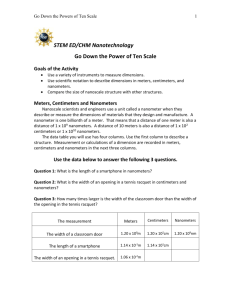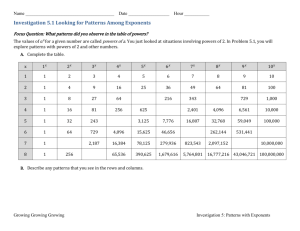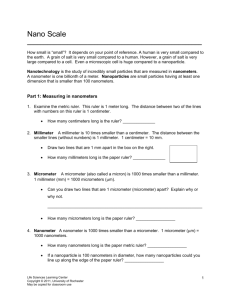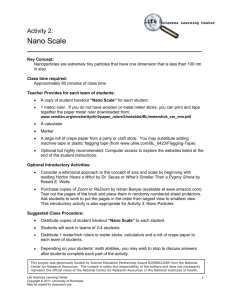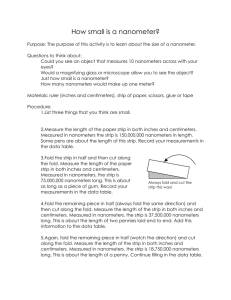STEM ED/CHM Nanotechnology 2007
advertisement
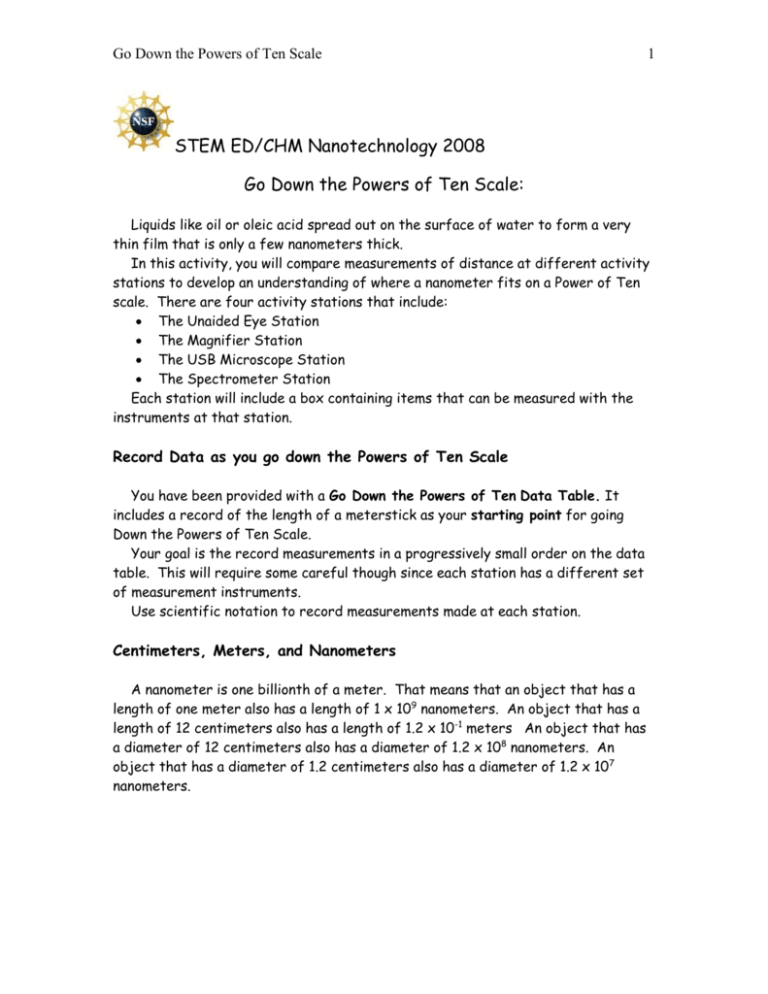
Go Down the Powers of Ten Scale 1 STEM ED/CHM Nanotechnology 2008 Go Down the Powers of Ten Scale: Liquids like oil or oleic acid spread out on the surface of water to form a very thin film that is only a few nanometers thick. In this activity, you will compare measurements of distance at different activity stations to develop an understanding of where a nanometer fits on a Power of Ten scale. There are four activity stations that include: The Unaided Eye Station The Magnifier Station The USB Microscope Station The Spectrometer Station Each station will include a box containing items that can be measured with the instruments at that station. Record Data as you go down the Powers of Ten Scale You have been provided with a Go Down the Powers of Ten Data Table. It includes a record of the length of a meterstick as your starting point for going Down the Powers of Ten Scale. Your goal is the record measurements in a progressively small order on the data table. This will require some careful though since each station has a different set of measurement instruments. Use scientific notation to record measurements made at each station. Centimeters, Meters, and Nanometers A nanometer is one billionth of a meter. That means that an object that has a length of one meter also has a length of 1 x 109 nanometers. An object that has a length of 12 centimeters also has a length of 1.2 x 10-1 meters An object that has a diameter of 12 centimeters also has a diameter of 1.2 x 108 nanometers. An object that has a diameter of 1.2 centimeters also has a diameter of 1.2 x 107 nanometers. Go Down the Powers of Ten Scale 2 The Unaided Eye Station The only measurement instrument at this station is a centimeter ruler. It can be used to record data for a section of the Powers of Ten Scale. Make measurements that are progressively smaller than 1 x 109 nanometers until you reach the limit of effectiveness of a centimeter ruler. Question 1: What factors limit the accuracy of your measurements using an unaided eye and a centimeter ruler? The Magnifier Station The measurement instruments at this station are a centimeter ruler and a magnifier. The instruments can be used to record data for a section of the Powers of Ten Scale. Question 2: What factors seems to limit the accuracy of your measurements using a magnifier and a centimeter ruler? The USB Microscope Station The measurement instruments are two centimeter rulers and a USB microscope. USB microscopes use computer software to produce an image on a computer screen and can be used to record measurements for a section of the Power of Ten Scale. More detailed information about the use of USB microscopes is available at the USB station. Question 3: How can you use centimeter rulers to calibrate the magnification of images on a computer screen that are created with the USB microscope’s software? Question 4: What factors limit the accuracy of your measurements using a USB microscope? Go Down the Powers of Ten Scale 3 The Spectrometer Station Two models of spectrometers are available at the Spectrometer Station. The larger blue spectrometer indicates the wavelengths of visible light in hundreds of nanometers. The numbers on the smaller, black spectrometer represent 1000 Å units (Angstroms). 5000 Angstroms is equal to 1 x 102 nanometers. Aim the narrow slit toward a fluorescent light on the ceiling. If you slowly move the spectrometer you can get one of the visible light spectrums to move onto a wavelength scale. The spectroscopes can be used to record the wavelength of a specific color of visible light in an appropriate row of the Go Down the Powers of Ten Scale Data Table. Question 5: What factors limit the accuracy of your measurements using a spectrometer? More Sophisticated (and much more expensive) Instruments An electron microscope would be required to measure the length of a protein molecule. Question 6: What is the length of a protein molecules (in nanometers) if its length is 0.000000027 meters? Record that length in an appropriate row of the Go Down the Powers of Ten Scale Data Table. An Atomic Force Microscope can be used to map objects much smaller than a protein molecule. Question 7: An object mapped with an Atomic Force Microscope has a depression with a depth of 2.2 nanometers? Record that depth in an appropriate row of the Go Down the Powers of Ten Scale Data Table. A Research Activity There may be some rows on the Go Down the Powers of Ten Scale Data Table that do not have recorded measurements. The Internet can be used to locate objects that have dimensions that can be recorded in those rows.
